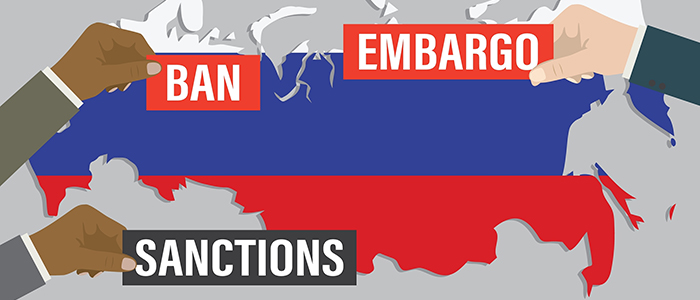
The beginning of the Russia-Ukraine war in February 2022, triggered significant sanctions by the United States (U.S.), the EU and other governments, targeting a wide range of Russian economic activities. Reports compare the current situation to the sanctions targeting Iran between the early 2000s and 2015.1 Indeed, while significant differences remain, such as the size and global interconnectedness of Russia’s economy, similarities exist. The sequencing and tactics employed while rolling out these new sanctions indicate that lessons from the last sanctions against Iran2 were implemented.
This article will look at the current and dynamic environment of the sanctions targeting Russia in light of the experience with sanctions against Iran. In addition, it will outline some of the key lessons that are implemented now and attempt to ascertain in which direction the sanctions environment may develop. Finally, the article will summarize some key steps that should be undertaken to avoid undue impact on compliance processes.
Multi-Layered Russia Sanctions
In the past few weeks, several new sanctions packages have been decided by the U.S., the EU and a range of governments around the globe. Starting with the declaration of the Russian Federation that it recognizes the breakaway regions of Donetsk and Luhansk as independent states and the movement of Russian military units into the separatist regions on February 21,3 the first package of sanctions was decided by the U.S. and the EU. This process accelerated after the invasion of further regions of Ukraine on February 244 and continues.
Currently, these sanctions measure primarily target parts of the Russian financial industry,5 including correspondence banking, the Central Bank of Russia and excludes a range of Russian banks from the Society for Worldwide Interbank Financial Telecommunication (SWIFT). They also include various trade control mechanisms6 on key technologies, such as banning the Russian airline industry in Europe and North America as well as targeted sanctions against key Russian government personnel and oligarchs.7 On March 8, both the U.S. and the EU decided to reduce their energy imports from Russia.8 On March 11, the EU decided to end Russia’s most favourite nation status and announced that it will work with the G7 to suspend the status of Russia in a range of multilateral financial institutions (FIs), including the International Monetary Fund and the World Bank, and that a task force had been set up in coordination with the G7 to target Russian key stakeholders. Furthermore, the EU bans the export of luxury goods as well as the import of Russian iron and steel and proposes a ban on EU investments in the Russian energy sector. The EU also will work to prevent the misuse of cryptocurrencies for sanctions evasion by Russia.9 This remains a very dynamic situation and further measures will likely be decided.
Sanctions on Russia: Iran on Steroids
The current speed and breadth of new sanctions measures are indeed unprecedented, but the major building blocks of the previous sanctions against Iran are all present. Sanctions against Russia have been implemented simultaneously and not over time, as was the case with Iran. Not only are specific Russian FIs targeted, but this is also done in tandem with correspondence banking restrictions, such as targeting the Central Bank of Iran and disconnecting targeted Russian FIs from the SWIFT system. This means that the time granted for adjusting Russia’s financial system to the new conditions is, to a large extent, denied. This is different from the sanctions against Iran to target the Iranian financial system. In the case of Iran, this was done over time to increase pressure in steps, rather than all at once.10 For example, disconnecting the Iranian financial system from the SWIFT system was only decided by the EU in 2012,11 several years after the EU began increasing sanctions pressure on Iran.
At the time of writing, several major Russian banks are excluded from these sanctions measures. For example, Sberbank is currently excluded from EU restrictive measures (i.e., sanctions),12 to ensure that EU member states can continue to pay for their imports of Russian energy. However, even if the EU does not decide on further measures, the already established U.S. and EU sanctions in tandem will very likely mean that transacting with Sberbank and other Russian FIs that are not yet sanctioned will become increasingly challenging. For example, several subsidiaries of Sberbank in the EU have already closed due to liquidity problems, and only one subsidiary in Switzerland remains operational.13
Furthermore, the international coalition’s willingness to implement similar sanctions measures nearly concurrently is broader than what it was in the case of Iran. At the time of writing, the UK, Australia, Canada, Japan, New Zealand, South Korea and Taiwan have decided similar measures.14 Switzerland fully aligned itself with EU measures.15 This is different from the sanctions against Iran, where the U.S. and the EU took the lead, and other countries reacted with similar measures only over time.
This quite broad initial coalition of several major global economies means that the Russian economy is increasingly isolated. Few options remain to compensate, such as greater cooperation with China. However, this may have its limits. For example, there is not sufficient pipeline capacity toward China to compensate for the planned Russian gas exports through the now-cancelled Nord Stream 2 project.16 This will mean that the Russian economy will likely continue to contract significantly over the foreseeable future.17 Furthermore, there will be increasing sparsity of U.S. dollars and euros in the Russian financial system due to financial sanctions and reduced energy exports to the EU. The cessation of exports to the U.S. may force a part of an increased China and Russia economic exchange to be based on barter deals, similar to the structures observed for a part of Iran’s oil exports.18
Finally, extremely similar to the situation in Iran—in addition to exterritorial effects of U.S. sanctions measures and secondary sanctions provisions also affecting individuals and entities without a U.S.-link—large companies have voluntarily decided to exit Russia on reputational concerns without being forced by sanctions provisions. These include companies in the energy sector. For example, Shell, the multinational oil and gas company, decided to end all projects in Russia, including projects with Gazprom.19 In addition, Shell decided to stop oil and gas purchases from Russia.20 Major brands in the clothing sector such as Nike21 or the luxury brand conglomerate LVMH have decided to close their stores in Russia.22 Even global chains such as McDonalds, are closing their restaurants in Russia, bending to reputational pressure.23 This trend will likely continue to increase over time,24 similar to businesses leaving Iran on reputational concerns after 2012.
Developing Russian Countermeasures
In reaction to the sudden and significant increase in sanctions pressure, Russia took several countermeasures. As a first step, Russia implemented a range of restrictions regarding transactions in foreign currencies.25 Furthermore, on March 8, Russia implemented additional measures by defining a number of countries as “unfriendly,” which means that Russian companies are restricted from cooperating with partners from these jurisdictions and will require prior approval. In addition, existing foreign debts with entities in these countries, exceeding the equivalent of 10 million rubles, can now be paid in rubles through special accounts with Russian banks,26 essentially capturing such debt payments within the Russian financial system. On March 9, the Central Bank of Russia introduced further restrictions on foreign currency trade.27 It is likely that Russia will decide on further countermeasures as the situation continues to escalate.28 These add to the increasing challenges foreign businesses will face operating in non-sanctioned sectors of the Russian economy.
Conclusion: High Time to Get Ready
Despite ongoing diplomatic meetings between representatives from Ukraine and Russia, including a high-level meeting in Turkey,29 all indicators point to a further escalation of the war in Ukraine. This also means that the sanctions pressure on Russia will increase further. Recent announcements by the U.S. and the EU to cease and reduce Russian energy imports already indicate the main future direction. Once these import reductions materialize, sanctions against additional Russian FIs, including those by the EU, are likely to happen. It also seems very likely that the list of sanctioned individuals and entities in Russia will further expand over time as both the EU and the U.S. react to sanctions aversions. The breadth of sanctions will also continue to evolve. On March 9, the EU decided on further its sanctions against Belarus, including suspensions of SWIFT services as well as targeting the Russian maritime industry and adding further individuals.30 Russian countermeasures are also likely to develop over time.
Therefore, it is crucial for compliance mechanisms to understand the exposure to Russia fully. This also includes collecting as much information on Russian counterparts, which has always been a challenge due to the relative opacity of Russian entities.31 Furthermore, internal defensive mechanisms should be established or strengthened. For example, existing agreements should be ringfenced to prevent additional risk exposure and where possible, it may be advisable to terminate existing agreements.32 Both increasing sanctions pressures, as well as Russian countermeasures, will make operations increasingly difficult and costly in reducing profit margins.
At the time of writing, it seems unlikely that the current sanctions situation will reverse in the short to medium term. Furthermore, as the period of relative wide-ranging sanctions relief for Iran between 2015 and 2018 demonstrated, if sanctions measures are maintained over a number of years, once they are partially or fully relieved, re-engagement with the targeted economy will take time due to continuing reputational concerns and nervousness about a potential reversal of the situation. Therefore, taking appropriate mitigation measures against sanctions exposure toward Russia will also be useful for the medium to long term.
Dr. Hans-Jakob Schindler, senior director, Counter Extremism Project (CEP), hjschindler@counterextremism.com
- Paul Sampson, Jaime Concha, “Russia Sanctions: What the Iran Precedent Tells Us,” Energy Intelligence Group, 25 February 2022, https://www.energyintel.com/0000017f-3195-d94d-a97f-77bd745b0000
- When the EU and the U.S. acted in unison to sanction Iran.
- “Putin Orders Troops to Separatist Regions and Recognizes Their Independence,” New York Times, 21 February 2022, https://www.nytimes.com/live/2022/02/21/world/ukraine-russia-putin-biden
- Natalia Zinets, Aleksandar Vasovic, “Missiles rain down around Ukraine,” Reuters, 24 February 2022, https://www.reuters.com/world/europe/putin-orders-military-operations-ukraine-demands-kyiv-forces-surrender-2022-02-24/
- “US Department of the Treasury: U.S. Treasury Announces Unprecedented & Expansive Sanctions Against Russia, Imposing Swift and Severe Economic Costs,” U.S. Department of the Treasury, 24 February 2022, https://home.treasury.gov/news/press-releases/jy0608
- “Fact Sheet: Joined by Allies and Partners, the United States Imposes Devastating Costs on Russia,” The White House, 24 February 2022, https://www.whitehouse.gov/briefing-room/statements-releases/2022/02/24/fact-sheet-joined-by-allies-and-partners-the-united-states-imposes-devastating-costs-on-russia/
- “EU restrictive measures in response to the crisis in Ukraine,” European Council, https://www.consilium.europa.eu/en/policies/sanctions/restrictive-measures-ukraine-crisis/
- “EU plans to cut Russian gas imports by two-thirds in a year,” Financial Times, 8 March 2022, https://www.ft.com/content/eac9498f-6a36-41a9-b577-fa37c0eeab76
- “Statement by President von der Leyen on the fourth package of restrictive measures against Russia,” European Commission, 11 March 2022, https://ec.europa.eu/commission/presscorner/detail/en/statement_22_1724
- “Sanctions 8: Timeline of Sanctions, The Iran Primer, 3 March 2021, https://iranprimer.usip.org/blog/2021/mar/03/sanctions-8-timeline-sanctions
- “SWIFT instructed to disconnect sanctioned Iranian banks following EU Council decision,” SWIFT, 15 March 2012, https://www.swift.com/insights/press-releases/swift-instructed-to-disconnect-sanctioned-iranian-banks-following-eu-council-decision
- Philip Blenkinsop, “EU bars 7 Russian banks from SWIFT, but spares those in energy,” Reuters, 2 March 2022, https://www.reuters.com/business/finance/eu-excludes-seven-russian-banks-swift-official-journal-2022-03-02/
- Joanna Partridge, “Russia’s Sberbank pulls out of Europe after facing failure amid sanctions,” Reuters, 2 March 2022, https://www.theguardian.com/business/2022/mar/02/russia-sberbank-pulls-out-of-europe-after-facing-failure-amid-sanctions
- Scott R. Anderson, Damon L. Burman, Austin Fraley, Bryce Klehm, Eden Lapidor, Emma Svoboda, “What Sanctions Has the World Put on Russia?,” Lawfare Blog, 4 March 2022, https://www.lawfareblog.com/what-sanctions-has-world-put-russia
- Philippe M. Reich, Meera Rolaz, “Switzerland adopts further comprehensive sanctions packages imposed by the European Union against Russia,” Baker McKenzie, 7 March 2022, https://sanctionsnews.bakermckenzie.com/switzerland-adopts-further-comprehensive-sanctions-packages-imposed-by-the-european-union-against-russia/
- Stella Yifan Xie, Chao Deng, “China’s Outreach to Russian Economy Extends Only So Far,” The Wall Street Journal, 1 March 2022, https://www.wsj.com/articles/chinas-outreach-to-russian-economy-extends-only-so-far-11646145595
- “Sanctions hit will see Russia economy contract 20% Q/Q in second quarter – JPMorgan,” Reuters, 28 February 2022, https://www.reuters.com/article/ukraine-crisis-russia-jpmorgan/sanctions-hit-will-see-russia-economy-contract-20-q-q-in-second-quarter-jpmorgan-idUSKBN2KX0LH
- Ebrahim Fallahi, “Promoting barter trade a great way of increasing exports,” Tehran Times, 27 October 2020, https://www.tehrantimes.com/news/453954/Promoting-barter-trade-a-great-way-of-increasing-exports
- “Shell to sell Russian investments due to Ukraine conflict,” BBC, 28 February 2022, https://www.bbc.com/news/business-60564265
- Kevin Granville, Eshe Nelson, Stanley Reed, “Shell says it will quit purchasing oil and gas from Russia, The New York Times, 8 March 2022, https://www.nytimes.com/2022/03/08/business/shell-oil-russia-ukraine.html
- Shoshy Ciment, “Nike, Under Armor and more retail companies are halting sales in Russia,” Sportico, 3 March 2022, https://www.sportico.com/business/commerce/2022/nike-under-armour-halt-russia-retail-sales-1234667101/
- Tim Stickings, “Luxury fashion brands leave Russia in response to Ukraine war,” The National News, 5 March 2022, https://www.thenationalnews.com/world/europe/2022/03/05/luxury-fashion-brands-leave-russia-in-response-to-ukraine-war/
- Sophie Mellor, “McDonald’s closes hundreds of restaurants in Russia after online criticism,” Fortune, 8 March 2022, https://fortune.com/2022/03/08/mcdonalds-russia-ukraine-social-media-movement/
- For an overview of companies that left Russia at the time of writing, see here: “These are the corporations that have pulled out of Russia since its invasion of Ukraine,” CBS, 8 March 2022, https://www.cbsnews.com/news/ukraine-russia-corporations-that-have-pulled-out/
- Alexander Bychkov, Vladimir Efremov, “Russia imposes special economic measures in response to Western sanctions,” Baker McKenzie, 1 March 2022, https://sanctionsnews.bakermckenzie.com/russia-imposes-special-economic-measures-in-response-to-western-sanctions/
- “Russia issues list of ‘unfriendly’ countries amid Ukraine crisis,” AlJazeera, 8 March 2022, https://www.aljazeera.com/news/2022/3/8/russia-deals-with-unfriendly-countries-require-moscow-approval
- “Russische Zentralbank schränkt Devisenhandel ein,“ FAZ, 9 March 2022, https://www.faz.net/aktuell/wirtschaft/wegen-sanktionen-russische-zentralbank-schraenkt-devisenhandel-ein-17863123.html
- For an overview of existing financial countermeasures until March 2, see: Vasilia Strizh, Valentina Semenikhina, “Update: Russia Adopts Countermeasures to Support its Financial Markets,” Morgan Lewis, 2 March 2022, https://www.morganlewis.com/pubs/2022/03/update-russia-adopts-countermeasures-to-support-its-financial-markets
- “‘No progress’ as top Russia, Ukraine diplomats talk in Turkey,” AlJazeera, 10 March 2022, https://www.aljazeera.com/news/2022/3/10/top-russia-ukraine-diplomats-arrive-in-turkey-for-talks
- “Ukraine: EU agrees to extend the scope of sanctions on Russia and Belarus,” European Commission, 9 March 2022, https://ec.europa.eu/commission/presscorner/detail/en/ip_22_1649,
For an overview of EU sanctions against Belarus, see here: “ Restrictive measures against Belarus” European Council, https://www.consilium.europa.eu/en/policies/sanctions/restrictive-measures-against-belarus/ - “Russia Beneficial Ownership Transparency,” Transparency International https://www.transparency.org/files/content/publication/2015_BOCountryReport_Russia.pdf
- Stacy Keen, Tom Stocker, “Russian sanctions: how businesses should prepare,” Pinsent Masons, 4 February 2022, https://www.pinsentmasons.com/out-law/analysis/russian-sanctions-how-businesses-prepare










